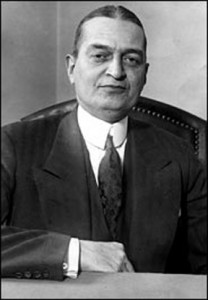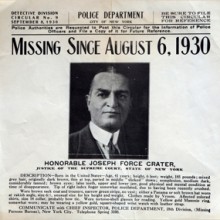
Judge Joseph Crater, Class of 1910
Just over 100 years ago, Easton, Pa., native Joseph Force Crater graduated from Lafayette and went on to become a New York State Supreme Court Justice, appointed in 1930 by then-Governor Franklin D. Roosevelt. Then four months later, he disappeared. One of the most notorious unsolved missing-person cases in history, two books and numerous magazine articles have probed the mystery, including a flurry of coverage in 2005 when a long-sealed letter revealed new information.
In The Man Who Never Returned (Overlook, 2010), novelist Peter Quinn imagines what became of Judge Crater. When he began his research, the New York City Police Department’s Missing Persons Squad discovered three accordion files that had been left on top of a file cabinet. Quinn, familiar with the case due to his father’s interest, realized that the files revealed details that had not been published. His father was a justice at the same Foley Square courthouse where Crater worked. In the novel, private investigator Fintan Dunne is hired by a media tycoon in 1955 to solve the case.
Crater was a snappy dresser, known for his tailored suits. When he disappeared he was wearing pearl-gray spats, a double-breasted brown suit with thin green stripes, and a Panama hat cocked at a sporty angle. He wore an old-fashioned detachable choker collar of starched linen and a gold Masonic ring.

Judge Joseph Crater, Class of 1910
Crater grew up in the house at 503 Ferry St., Easton, which was restored in 1988. He graduated first in his class at Easton High in 1906 and won a scholarship to Lafayette. He received his law degree from Columbia University.
As the story goes, on Wednesday, Aug. 6, 1930, Crater entered Billy Haas’s restaurant at 332 West 45th St., just beyond Eighth Avenue and met his friend, William Klein, attorney for the Shubert brothers, and Sally Lou Ritz, a Shubert show girl. He had a ticket for Dancing Partner, playing at the Belasco Theater. They all departed about 9 p.m. Crater hailed a taxicab heading west on 45th; Klein and Ritz reported later that they watched it depart and then they headed east toward the Shubert office.
Crater was never seen again.
At the time, his wife, Stella Wheeler Crater, whom he married in 1917, was at their summer home in Belgrade Lakes, Maine. Crater had been with her until he received a disturbing phone call on Sunday, Aug. 3. He left for New York by train and promised to return the following Saturday, Aug. 9. When he didn’t return, Stella hired a private detective to find him. Carter’s law firm, Wagner, Quillinan, and Rifkind, was also searching for him. Finally, on Sept. 3, Simon H. Rifkind went to police headquarters and made a full report.
A huge investigation began, with the city offering a $5,000 reward. The results revealed that he was involved with a number of chorus girls, one of whom, Vivian Gordon, was murdered by gangland assassins shortly after Crater’s disappearance and just before she was scheduled to testify against the policy in an unrelated corruption case.

Judge Joseph Crater, Class of 1910, disappeared mysteriously more than 80 years ago.
On the day of his disappearance, Crater gathered a stack of files and folders from his office, and along with his personal assistant, took them to his apartment. He also gave his assistant two checks, for $3,000 and $2,100, and asked him to cash them for bills of large denominations. Crater put the envelopes in the inside pocket of his suit jacket.
When Stella returned to their New York apartment on Jan. 21, she opened a secret drawer in her dresser and found three envelopes with cash, stock certificates, and several insurance policies on her husband’s life. The fourth contained a confidential memo to her, which ended with “Am very weary, Love, Joe.” She reported all to the district attorney.
After three years, the city withdrew the reward and the police’s missing persons bureau only followed leads in the metro area. Tips from farther away were relayed to local police for investigation. In 1939, Stella had Crater declared legally dead. In her book about the incident, The Empty Robe (1961), she declared that her husband was true to her and that the reports about the other women were lies. The case was closed in 1979.
In Vanishing Point: The Disappearance of Judge Crater and the New York He Left Behind (2004), Richard J. Tofel chronicles the Crater story in the context of the decline and fall of Tammany Hall, the New York County Democratic Party machine.
A year later, a letter sealed in an envelope marked “do not open until my death,” was found by family members in the safe deposit box of Stella Ferrucci-Good who died April 2. She claimed that her late husband, Robert Good, told her on his deathbed that he had overheard a conversation between New York policeman Charles Burns, and his cab driver brother, Frank Burns, who with several accomplices had killed Crater and buried him on Coney Island, under the boardwalk near West Eighth St., current site of the New York Aquarium.
An Aug. 20, 2005, New York Times article by William K. Rashbaum reports that police were not able to find records of any bodies found in the area, which was excavated in the mid-1950s for construction of the aquarium. He also reported that Tofel expressed skepticism about the version of events in the letter. Tofel said he was not able to find any accounts of witnesses who saw the judge get into a taxi.



1 Comment
Comments are closed.